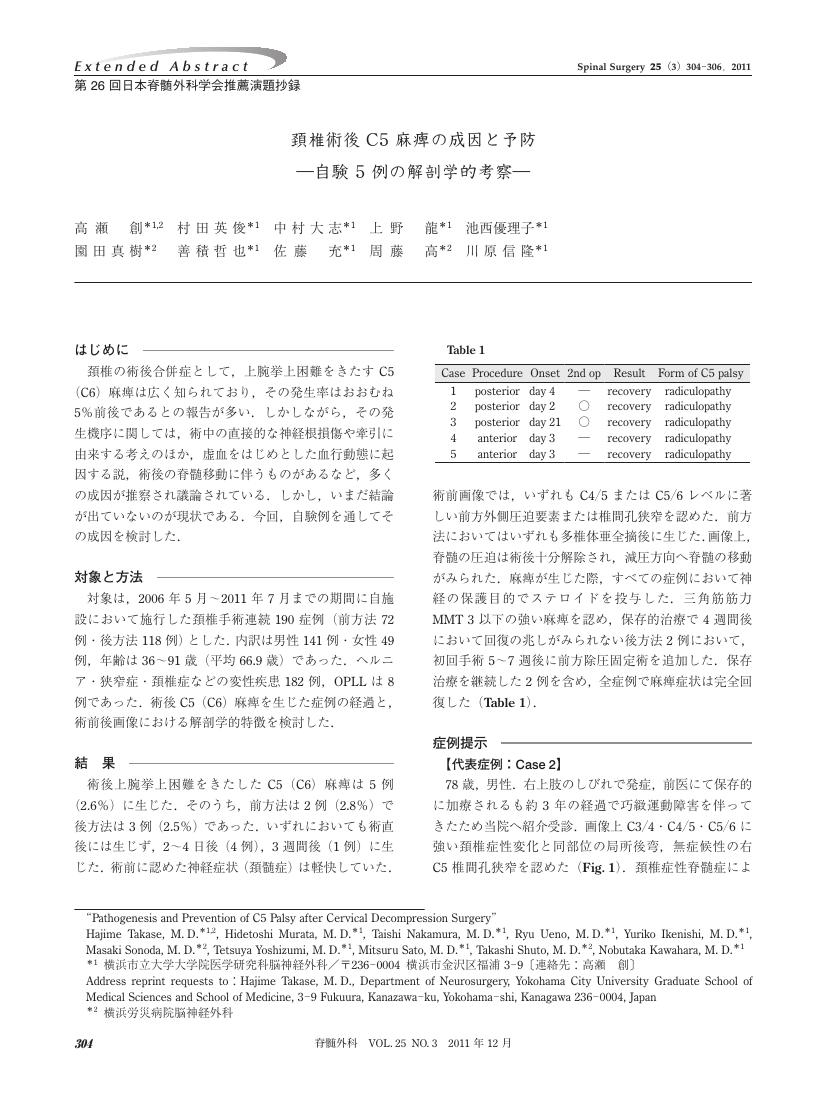2 0 0 0 OA 頚椎術後C5麻痺の成因と予防
2 0 0 0 OA 直達手術を施行した脳幹海綿状血管腫5例の検討
- 著者
- 田中 貴大 周藤 高 末永 潤 高瀬 創 佐藤 充 大竹 誠 立石 健祐 上野 龍 宮崎 良平 村田 英俊
- 出版者
- 一般社団法人 日本脳卒中の外科学会
- 雑誌
- 脳卒中の外科 (ISSN:09145508)
- 巻号頁・発行日
- vol.46, no.1, pp.58-64, 2018 (Released:2018-02-14)
- 参考文献数
- 17
We report herein five cases of symptomatic brainstem cavernous malformations (CM). Specific surgical approaches were designed to directly access each lesion. Neuronavigation and intraoperative monitoring were used. Four lesions underwent gross total resection, and one was subtotally partially removed. None of the patients developed new neurological deficits and all cases showed an improvement based on the modified Rankin Scale and the Karnofsky Performance Status. Although brainstem CM have a relatively high rate of re-bleeding, thus adversely affecting the neurological status of the patient, recent reports have demonstrated favorable outcomes after their resection. Hence, surgical removal can be recommended for cases of symptomatic brainstem CM, particularly those with re-bleeding. An optimal surgical approach, providing direct access to the lesion, is critical for successfully resecting brainstem CM.
1 0 0 0 OA 脳動静脈奇形に対するガンマナイフ治療後の囊胞形成
- 著者
- 周藤 高 松永 成生 末永 潤 猪森 茂雄 藤野 英世
- 出版者
- 一般社団法人 日本脳卒中の外科学会
- 雑誌
- 脳卒中の外科 (ISSN:09145508)
- 巻号頁・発行日
- vol.38, no.4, pp.228-234, 2010 (Released:2011-04-29)
- 参考文献数
- 23
- 被引用文献数
- 3 3
We retrospectively studied 15 patients, 9 men and 6 women aged 17 to 52 years (mean 28.1 years), who developed cyst formation following gamma knife radiosurgery (GKS) at our hospital for cerebral arteriovenous malformation (AVM). The mean nidus volume was 11 cm3 (0.1-26.7 cm3), and the mean prescription dose at the nidus margin was 20.0 Gy (18-28 Gy). Nidus obliteration was obtained in 9 patients, partial obliteration in 5, and no change in 1. Cyst formation was detected from 2.5 to 13.5 years (mean 6.4 years) after GKS. Three patients underwent craniotomy, and 2 received placement of an Ommaya reservoir. Spontaneous regression of cyst was observed in 2 patients. The outcome of the cyst was unknown in 2 patients, because of no response from the neurosurgeon the patients were referred to. Serial magnetic resonance imaging was performed in the other 6 patients because the cyst size was stable or asymptomatic. These findings suggest that cyst formation following GKS is not a “late complication.” Placement of an Ommaya reservoir or cyst-peritoneal shunt is recommended for cysts with obliterated nidus. Craniotomy should be considered if the nidus is not completely obliterated or the cyst is associated with an expanding hematoma. Serial follow-up imaging is recommended for asymptomatic patients.
